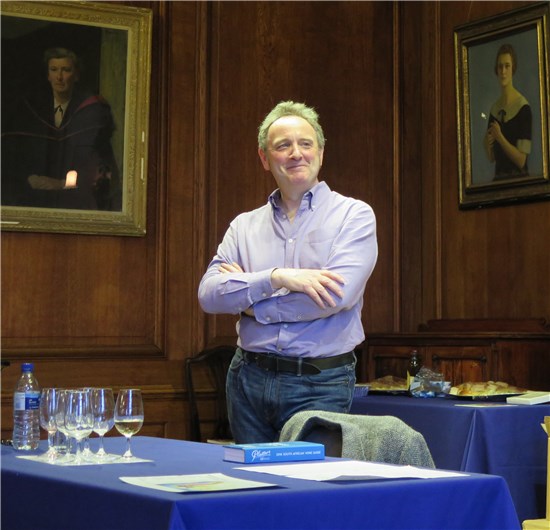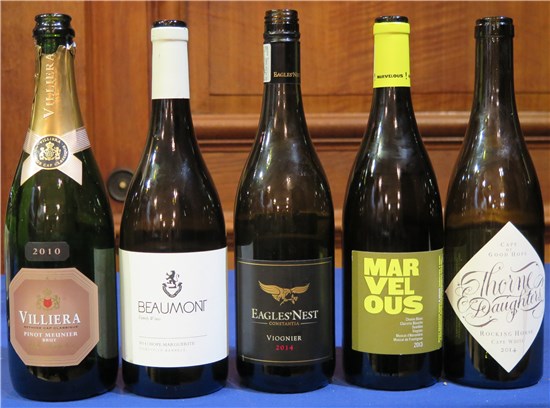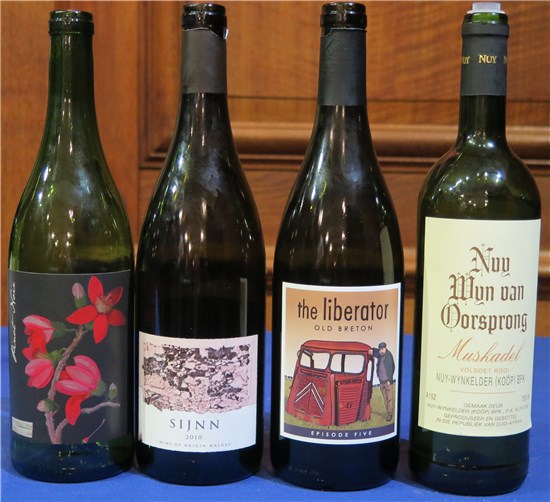 This was Richard’s sixth visit to the Oxford Wine Club, but who’s counting? When he last presented South Africa to us in 2012, his alter ego, Rick, The Wine Liberator (see www.theliberatorwine.com) was in its infancy.
This was Richard’s sixth visit to the Oxford Wine Club, but who’s counting? When he last presented South Africa to us in 2012, his alter ego, Rick, The Wine Liberator (see www.theliberatorwine.com) was in its infancy.
 2016 sees the Liberator project going from strength to strength, with his Episode Six recently receiving the ultimate endorsement of being Jancis Robinson’s wine of the week, and Richard returning to talk about the New Wave of South African wines.
2016 sees the Liberator project going from strength to strength, with his Episode Six recently receiving the ultimate endorsement of being Jancis Robinson’s wine of the week, and Richard returning to talk about the New Wave of South African wines.
Richard’s interest in South Africa began when his MW dissertation took him there in 1993. Back then, everything was changing with the end of apartheid and Nelson Mandela poised to become South Africa's first black president. This set the scene for our wines – all, bar the first producer featured, had set up in the post apartheid era.
 Our opening wine was a sparkling ‘Cap Classique’ from Villiera, based in Stellenbosch. This family run business was one of the original sparking producers, having bought the estate in 1983, and is now recognised one of the top 5 South African sparkling producers. The wine was a one-off 10,000 bottle experiment, made with 100% Pinot Meunier - this would be rare in Champagne, but Richard believes this is the only 100% Pinot Meunier sparkling wine from South Africa. It combines fruit (citrus, stone and red) with biscuity notes on the nose (having spend 5 years on lees) and has a lovely balanced, rich, creamy palette with good length. You can’t buy this in South Africa as it was all exported to the UK market. Our verdict was it’s rather nice and excellent value too!
Our opening wine was a sparkling ‘Cap Classique’ from Villiera, based in Stellenbosch. This family run business was one of the original sparking producers, having bought the estate in 1983, and is now recognised one of the top 5 South African sparkling producers. The wine was a one-off 10,000 bottle experiment, made with 100% Pinot Meunier - this would be rare in Champagne, but Richard believes this is the only 100% Pinot Meunier sparkling wine from South Africa. It combines fruit (citrus, stone and red) with biscuity notes on the nose (having spend 5 years on lees) and has a lovely balanced, rich, creamy palette with good length. You can’t buy this in South Africa as it was all exported to the UK market. Our verdict was it’s rather nice and excellent value too!
It wouldn’t be a South African tasting without Chenin Blanc (also Richard’s desert island grape variety although on his desert island it would not be from South Africa) and the next wine was a single varietal example. Beaumont - ‘Hope Marguerite’ Chenin Blanc 2014 is an extreme example of Chenin akin to some of the modern producers in the Loire. The estate is in the Bot River area, just an hour or so outside of Cape Town, and dates back to the 1700s. It was bought by Raoul and Jayne Beaumont in 1973 and farmed as a going concern – the grapes grown at that time were sent to the co-operative, likely destined for distillation. In 1993 the couple decided to start producing their own wines, opening up old cellars, with their first vintage in 1996. Grapes from the oldest vineyards with a little botrytis and lots of new wood and battonage during winemaking produce really full bodied wine with lots of fresh acidity too.
The third wine was a 2014 Viognier from Eagles’ Nest, one of the newer estates. the estate is cradled in a secluded valley high up on the slopes of the historic Constantia mountain range, which forms part of the World Heritage Site, Table Mountain. After devastating fires that raged through the Cape in the summer of 2000, the old farm was mostly destroyed, except for the historic buildings, the owners decided to replace the former pine forest with vines, selecting varieties that best suited this (unique in the area) north facing terroir: Syrah, Merlot and Viognier. In Richard’s opinion, this relatively restrained and delicate wine is the best Viognier from the Southern Hemisphere - it’s served in British Airway 1st class, so he is not alone!
The next 2 Cape White blends took us to a new and exciting wine style, that is generating some of the most interesting wines coming out of South Africa (in Richard’s opinion) :
- The first, Yardstick - Marvelous Yellow (2013), is Mulderbosch winemaker (formerly at Klein Constantia), Adam Mason’s own ‘side’ project. It positions itself as a pioneering blend - Chenin, Clairette, Viognier and Semillon, with a twist. It also has a small, but identifiable, addition of Muscat (Muscat Ottonel and Muscat de Frontignan) that has been desiccated by twisting whole bunches on the vine – a technique adapted by Adam from his time working as winemaker at Klein Constantia.
- The second Cape White Blend was entirely different, but equally interesting and with a local connection…. Thorne & Daughters’ UK trained winemaker John Seccombe worked in Oxford’s Quad restaurant in a past life. In ‘Rocking Horse’ (2014) John has elected to lead with Roussanne, incorporating both Chardonnay and Old vine Semillon (Semillon Gris) along the way, and only a little Chenin. The project started at the back-end of 2012 and takes inspiration for the names of the wines from his two young daughters. A rare wine with lots going on - sadly (as this was my personal favourite of the night), we consumed the last 4 bottles available in the UK!
 Moving onto the reds, we started with Pinot Noir from Botanica (2013). Pinot Noir is still a minority grape variety in South Africa representing only about 1% of production. American-born, Ginny Povall makes wine whilst simultaneously running a luxury guest lodge and protea farm. She doesn’t own any vineyards (the grapes were sourced from the Hemel en Aarde Valley for this vintage) and is a self taught winemaker, arriving in the Cape in 2008 with some basic knowledge of winemaking through evening and weekend courses spent at UC Davis and ‘a ton of reading’ over the years. This is just her third attempt at Pinot Noir. This wine itself was reminiscent of a cool climate Pinot - restrained and well structured with fresh acidity balanced with juicy cherries and redcurrants.
Moving onto the reds, we started with Pinot Noir from Botanica (2013). Pinot Noir is still a minority grape variety in South Africa representing only about 1% of production. American-born, Ginny Povall makes wine whilst simultaneously running a luxury guest lodge and protea farm. She doesn’t own any vineyards (the grapes were sourced from the Hemel en Aarde Valley for this vintage) and is a self taught winemaker, arriving in the Cape in 2008 with some basic knowledge of winemaking through evening and weekend courses spent at UC Davis and ‘a ton of reading’ over the years. This is just her third attempt at Pinot Noir. This wine itself was reminiscent of a cool climate Pinot - restrained and well structured with fresh acidity balanced with juicy cherries and redcurrants.
Our second red was Sijnn - Malgas Red (2010) another pioneering winery (the vineyards are just 10 years old in an area 100 km from the previously nearest established vineyards) and another interesting South African blend – this time of Syrah, Touriga Nacional, Mourvedre, Trincadeira and Cabernet Sauvignon. David and Rita Trafford’s goal is to produce wines that speak of the place they come from and there is a characteristic salinity and pithiness in this wine that Richard believes to be exactly this. A Jancis Robinson ‘wine of the week’ and in our view, a big and warming wine with rich spice, black fruit and minerality perfectly balanced with the right amount of acidity and tannin.
The final red was one that Richard is directly responsible for; “I am the Liberator” he declared and then went on to give a fascinating insight into the process of developing these propositions. Richard made it sound so easy - he tasted this in barrel and asked the wine maker if he could have a couple barrels to bottle himself - I’m sure it wasn’t that simple! Episode Five, Old Breton (2013) is a delicious Cabernet Franc brining us back to Richard’s Loire heritage. His parting comment sums it up: “Every wine has a story, I hope you like it! And once they are gone, they’re gone”
 The evening drew to a close with Nuy Muscadel, something of a South African institution according to Richard, although barely known outside of South Africa. This co-operative produced wine wins acclaim with every vintage, but in essence it is a simple, sweet, and ridiculously inexpensive fortified dessert wine; delicious when young (fresh, clean and grapey), but also with great potential for ageing (becoming more viscous and richer). It can be served over crushed ice in the summer, at room temperature in the winter and goes well with blue cheese and chocolate.
The evening drew to a close with Nuy Muscadel, something of a South African institution according to Richard, although barely known outside of South Africa. This co-operative produced wine wins acclaim with every vintage, but in essence it is a simple, sweet, and ridiculously inexpensive fortified dessert wine; delicious when young (fresh, clean and grapey), but also with great potential for ageing (becoming more viscous and richer). It can be served over crushed ice in the summer, at room temperature in the winter and goes well with blue cheese and chocolate.
In short, Richard led us on a wonderful tour of what’s going on in South African at the moment. We tried a really interesting range of experimental wines and heard the back stories behind them all. Many thanks to him for putting on such an excellent evening for us - I for one am looking forward to his seventh visit already!
Evelyn Joslin, April 2016